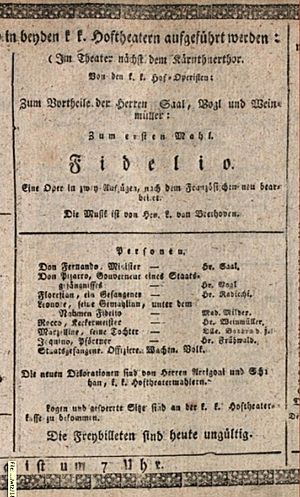Fidelio facts for kids
Fidelio is the only opera ever written by the famous composer Ludwig van Beethoven. It's a German opera that tells an exciting story about a brave woman named Leonore. She dresses up as a male prison guard called "Fidelio" to rescue her husband, Florestan, who is unfairly locked away in a political prison.
Fidelio is a special kind of opera called a "rescue opera." In these stories, a hero or heroine has to fight against mean people to save someone they love. This opera was created around the time of the French Revolution, when people everywhere were talking about ideas like freedom and peace. These ideas often led to wars across Europe. The famous "Prisoners' Chorus" in Fidelio is a powerful song about freedom, much like the final part of Beethoven's Ninth Symphony.
Beethoven worked on Fidelio for a long time to make it perfect. The first version, performed in 1805, was a three-act opera called Leonore. Some people in the audience, especially French military officers, felt like the opera was criticizing them. In 1806, it was performed again with two acts and a new overture, now known as "Overture: Leonore No. 3." However, disagreements between Beethoven and the theater managers stopped further shows. Eight years later, Beethoven changed his opera one more time. This version was called Fidelio, and it became a huge success. It has been a famous opera ever since.
Contents
The Story of Fidelio
The story takes place in a Spanish state prison. It's located a few miles from Seville, in the late 1700s.
Act I: The Prison Yard
Jaquino is a prison guard who wants to marry Marzelline. Marzelline is the daughter of Rocco, the prison warden. But Marzelline has just fallen in love with someone she believes is a man named Fidelio.
Fidelio is actually Leonore, a woman who has dressed up as a man. She did this to get inside the prison. Her husband, Florestan, is a prisoner there because of his political beliefs. Leonore is pretending to love Marzelline so she can find a way to rescue Florestan. Rocco says he is happy for Marzelline to marry Fidelio.
Leonore (as Fidelio) says she will help Rocco with his job of looking after the prisoners. Rocco agrees, but tells her there's one prisoner she cannot guard. This prisoner has been locked up alone for two years. Leonore thinks it might be her husband, but she isn't sure.
Don Pizarro is the military governor of the prison. He hears that inspectors are coming to check if the prison is managed correctly. Pizarro knows he shouldn't have locked Florestan up. So, he decides to kill Florestan before the inspection starts. He asks Rocco to dig a grave to quickly hide the body. Rocco doesn't want to do this, but he has to agree.
Leonore then lets the prisoners walk in the garden. Rocco tells Leonore that he needs her help to dig the grave. Pizarro is very angry that the prisoners are walking in the garden. But Rocco says they should be allowed because it's the King’s name-day. Rocco then says they should be locked up again.
Act II: Florestan's Cell and Freedom
Florestan sits alone in his dark cell. In his mind, he imagines an angel who looks like his wife. This angel seems to be telling him to come to Heaven.
Leonore goes with Rocco to the prisoner's cell. She is still not sure if it's her husband. She gives the prisoner some bread. When Pizarro arrives, he gets ready to kill Florestan. But Leonore bravely stands between them. She tells Pizarro she will shoot him if he comes closer.
Suddenly, a trumpet plays a fanfare. This means the Minister is arriving!
Outside the prison, the Minister announces that all the prisoners are now free. He is shocked to find Florestan among the prisoners, because Florestan is his friend. The crowd demands that Pizarro be punished. Leonore frees her husband from his chains. The crowd cheers, calling her a great heroine.
The Different Overtures
Beethoven changed his opera several times. This included writing four different overtures, which are pieces of music played at the beginning of an opera. They are called "Leonore 1," "Leonore 2," "Leonore 3," and "Fidelio."
The overture "Fidelio" is the one usually played at the start of the opera today. "Leonore 2" was the overture used for the very first performance in 1805. "Leonore 3," written in 1806, is the most famous of the overtures. "Leonore 1" might have been written in 1805, or it might have been for a show in Prague in 1807 that never happened.
Sometimes, the "Leonore 3" overture is played during Act II, between the two scenes. However, many people think it doesn't fit well there dramatically. Today, it is usually heard as a separate concert piece. The overture "Fidelio" was composed for the opera performances in 1814.
Images for kids
-
Lotte Lehmann as Leonore
See also
 In Spanish: Fidelio para niños
In Spanish: Fidelio para niños







